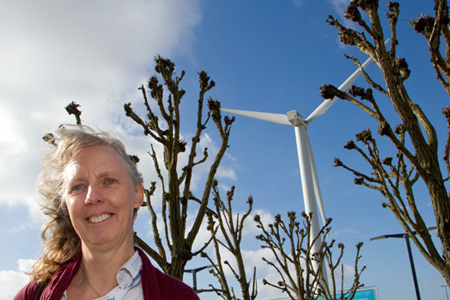Even though offshore wind farms are incredibly expensive—and a great deal of time is devoted to planning them—communication between project developers leaves a lot to be desired. Simply put: one expert often has little idea what another is doing, and this costs a lot of time and money. However, this situation may soon be history thanks to a new tool developed by DTU Wind Energy in Roskilde.
Senior Researcher Charlotte Bay Hasager was project manager for the development of the new tool which was presented at a trade fair for offshore wind energy held in Copenhagen in March.
The project, which has been given the rather tongue-twisting title of EERA-DTOC (European Energy Research Alliance—Design Tool for Offshore Wind Farm Cluster) involved gathering all the different models that use their own methods to calculate how and where a wind farm can best be established at an offshore site.
In all, ten different academic partners contributed 20 different models that have now been aligned to allow offshore wind farm developers to perform consolidated calculations of everything from geographical location to the distance between the individual turbines.
“Offshore wind farms are generally constructed by major companies and it is not uncommon for these companies to have a department that employs meteorologists who have one view of the world, while the employees of a different department at the same company are tasked with calculating what the power conductor cables cost and therefore see things very differently,” explains Charlotte Bay Hasager.
Ever since the advent of offshore turbines, models have been used to calculate different aspects of the process and find the best solutions—but each from its own individual perspective. It is communication problems such as these that the new model is designed to tackle.
Charlotte Bay Hasager presents a classic example:
“Behind every turbine, there is a ‘shelter effect’ that hinders the next turbine in line from generating as much energy as the one in front of it. Taking this effect into account allows planners to prepare models that calculate where the turbines need to be positioned in relation to each other. But then a completely different model is used to work out what it will cost to run cables between all the turbines. And according to this model, it naturally makes more sense to place the turbines as close together as possible.”

“We haven’t actually created any new models with our tool, but we have aligned the existing ones and compiled them in a shared database that everyone can use. Photo: Bertel Henning Jensen.
From the infancy of computers
“The tool we’ve created is a good one. The next step is to see if it builds up a following in the sector; we hope that it will, because when we started work on the project, there were a lot of people who doubted that it could actually be done,” days Hans-Peter Waldl from the German company Overspeed, which has taken over commercial operation of the tool.
One of the reasons for the initial scepticism was that the systems that are now linked together span the entire spectrum from modern, hi-tech models, to basic tools programmed on an old IBM 80286 computer.
However, the team behind the project have the backing of Jan Matthiesen, Technology Acceleration Manager for Carbon Trust, a British fund that supports green enterprises and initiatives.
In Charlotte Bay Hasager’s view, it is first and foremost about generating cheaper electricity for consumers:
"The price of offshore wind farms has to fall before they become completely profitable, and we’re now helping the industry to reach this goal by putting operators a position to plan the farms more accurately. This will inevitably benefit us all,” she says.
Article in DTUavisen no. 4, April 2015.